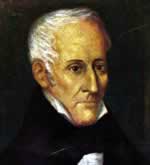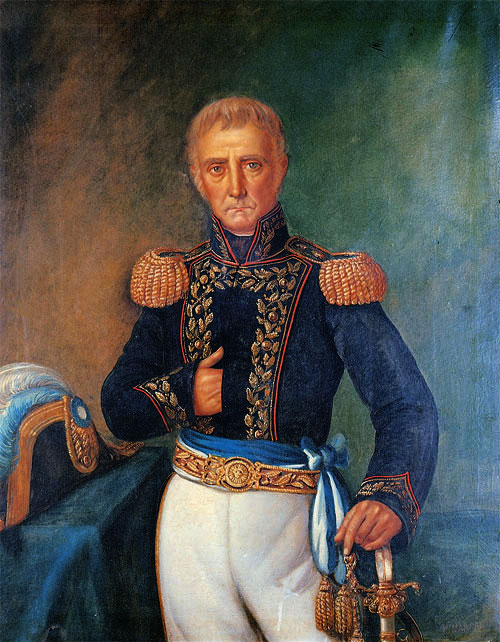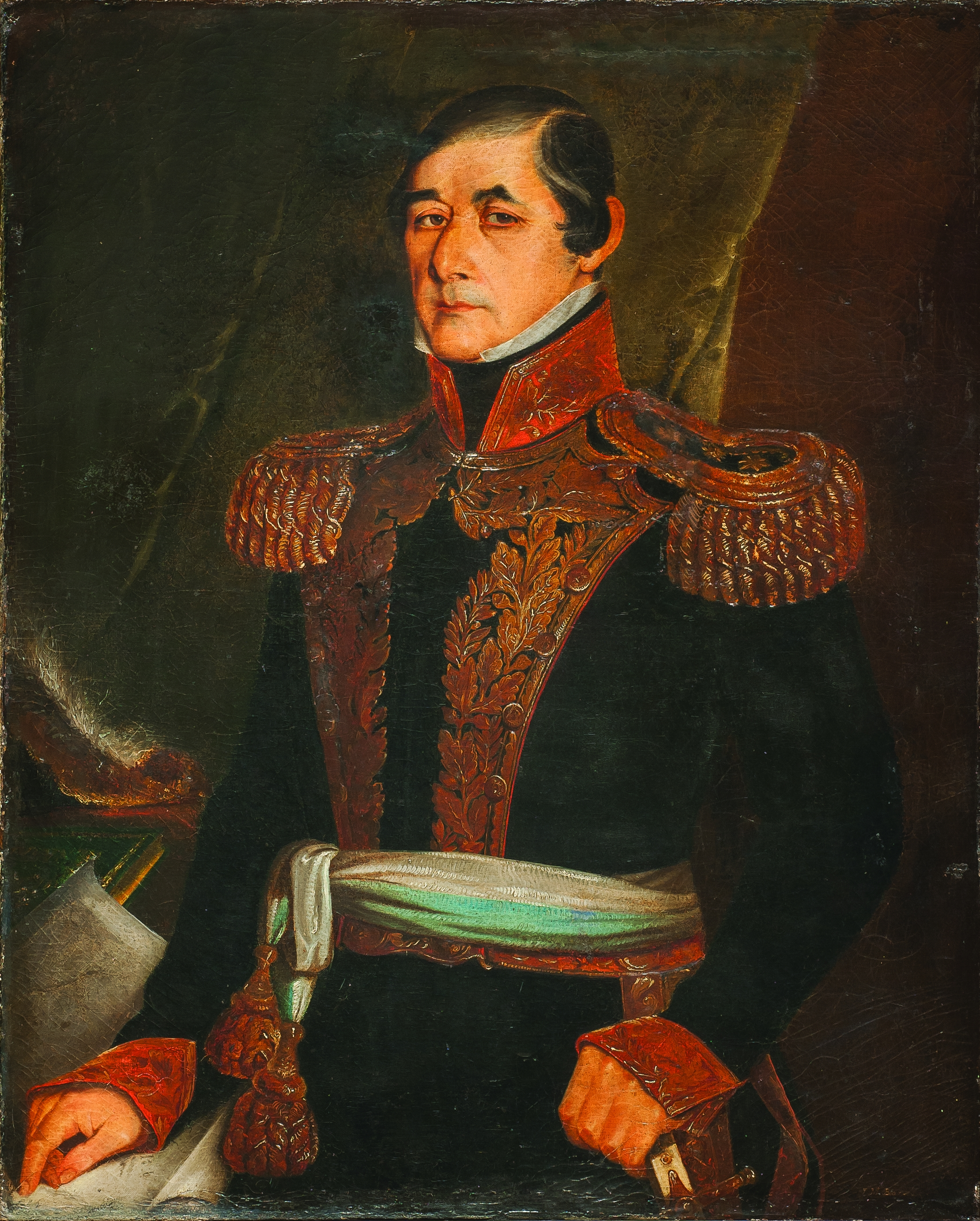|
José Rondeau
José Casimiro Rondeau Pereyra (March 4, 1773 – November 18, 1844) was a general and politician in Argentina and Uruguay in the early 19th century. Life and Politics He was born in Buenos Aires but soon after his birth, the family moved to Montevideo, where he grew up and went to school. At the age of twenty, he joined the armed forces in Buenos Aires, but later transferred to a regiment in Montevideo. During the British invasion of 1806, he was captured and sent to England. After the defeat of the British troops, he was released and went to Spain, where he fought in the Napoleonic Wars. When he returned to Montevideo in August 1810, he joined the independentist forces and was nominated military leader of the independentist armies of the ''Banda Oriental'', later Uruguay. His military successes in the various battles for Montevideo (including the Siege of Montevideo (1812–14)) won him the post of the military leader of the campaign in Peru, replacing José de San Martí ... [...More Info...] [...Related Items...] OR: [Wikipedia] [Google] [Baidu] |
Supreme Director Of The United Provinces Of The Río De La Plata
The Supreme Director of the United Provinces of the Río de la Plata ( es, Director Supremo de las Provincias Unidas del Río de la Plata) was a title given to the executive officers of the United Provinces of the Río de la Plata according to the form of government established in 1814 by the ' (Assembly of Year XIII). The supreme director was to wield power for a term of two years. The assembly hoped to confront the royalists, who had been emboldened by internal dissension within the patriotic faction. To prevent abuses of power, the directorship would be combined with a state council of nine members and would be required to answer to a congress empowered to carry out legislation. After the resignation of José Rondeau following the unitarian defeat at the Battle of Cepeda, the office of Supreme Director was briefly assumed by Juan Pedro Aguirre. He endorsed the Buenos Aires Cabildo to name a governor for the province of Buenos Aires as the national congress dissolved itself on ... [...More Info...] [...Related Items...] OR: [Wikipedia] [Google] [Baidu] |
British Invasions Of The Río De La Plata
The British invasions of the River Plate were two unsuccessful British attempts to seize control of areas in the Spanish colony of the Viceroyalty of the Río de la Plata that were located around the Río de la Plata in South America – in present-day Argentina and Uruguay. The invasions took place between 1806 and 1807, as part of the Napoleonic Wars, when Spain was an ally of Napoleonic France. History The invasions occurred in two phases. A detachment from the British army occupied Buenos Aires for 46 days in 1806 before being expelled. In 1807, a second force stormed and occupied Montevideo, remaining for several months, and a third force made a second attempt to take Buenos Aires. After several days of street fighting against the local militia and Spanish colonial army, in which half of the British forces were killed or wounded, the British were forced to withdraw. The social effects of the invasions are among the causes of the May Revolution. The criollos, who had so ... [...More Info...] [...Related Items...] OR: [Wikipedia] [Google] [Baidu] |
List Of Heads Of State Of Argentina
Argentina has had many different types of heads of state, as well as many different types of government. During pre-Columbian times, most of the territories that today form Argentina were inhabited by Amerindian peoples without any centralized government, with the exception of the Inca subjects of the Northwest and Cuyo regions. During the Spanish colonization of the Americas, the King of Spain retained the ultimate authority over the territories conquered in the New World, appointing viceroys for local government. The territories that would later become Argentina were first part of the Viceroyalty of Peru and then the Viceroyalty of the Río de la Plata. The May Revolution started the Argentine War of Independence by replacing the viceroy Baltasar Hidalgo de Cisneros with the first national government. It was the Primera Junta, a junta of several members, which would grow into the Junta Grande with the incorporation of provincial deputies. The size of the juntas gave room to i ... [...More Info...] [...Related Items...] OR: [Wikipedia] [Google] [Baidu] |
Great Siege Of Montevideo
The Great Siege of Montevideo ( es, Gran Sitio de Montevideo), named as ''Sitio Grande'' in Uruguayan historiography, was the siege suffered by the city of Montevideo between 1843 and 1851 during the Uruguayan Civil War.Walter Rela (1998). Uruguay: República Oriental del Uruguay, 1830-1864'. Montevideo: ALFAR. In practice, this siege meant that Uruguay had two parallel governments: *Gobierno de la Defensa in Montevideo, led by Joaquín Suárez (1843 – 1852) *Gobierno del Cerrito (with headquarters in the present-day neighborhood of Cerrito de la Victoria), ruling the rest of the country, led by Manuel Oribe (1843 – 1851) The siege inspired a book by the French writer Alexandre Dumas, ''The New Troy'' (1850). See also * Gobierno de la Defensa * Gobierno del Cerrito * Uruguayan Civil War References Bibliography * Bruce, George Harbottle (1981). ''Harbottle's Dictionary of Battles''. Van Nostrand Reinhold. * Casas, Lincoln R. Maiztegui (2005). ''Orientales: una histo ... [...More Info...] [...Related Items...] OR: [Wikipedia] [Google] [Baidu] |
Uruguayan Civil War
The Uruguayan Civil War, also known in Spanish as the ''Guerra Grande'' ("Great War"), was a series of armed conflicts between the leaders of Uruguayan independence. While officially the war lasted from 1839 until 1851, it was a part of armed conflicts that started in 1832 and continued until the final military defeat of the ''Blancos'' faction in 1904. Out of supporters of presidents Rivera and Oribe grew the Colorado Party and the National Party, both of which received backing and support from foreign sources, including neighboring Empire of Brazil, the Argentine Confederation, Buenos Aires Province as well as European powers, primarily the British Empire and the Kingdom of France, but also a legion of Italian volunteers including Giuseppe Garibaldi. The great diversity of nationalities among the military forces supporting the Colorado Party posed difficulties in arguing for their struggle in terms of a "national liberation"; instead, the Colorado Party side argued that they ... [...More Info...] [...Related Items...] OR: [Wikipedia] [Google] [Baidu] |
Provisional Governorship Of José Rondeau
The provisional governorship of José Rondeau was the pre-Constitution of Uruguay of 1830, Constitution government period of Uruguay which began with his oath and inauguration as the Governor and Captain General of Uruguay, recently becoming independent and also known as the State of Montevideo, after being summoned by the Constitutional and Legislative General Assembly to take office, and lasted until 17 April 1830 with his resignation. Background In order to put an end to the Cisplatine War that disputed the sovereignty of the Oriental Province and the Oriental Missions territories, the United Provinces of the Río de la Plata, United Provinces of the River Plate and the Empire of Brazil signed in August 1828 a Preliminary Peace Convention (1828), Preliminar Peace Convention, agreeing to resign from their claims to the State of Montevideo and to declare it as an independent country. Once the convention was ratified by each of the contracting parties, by Brazil on 30 August, si ... [...More Info...] [...Related Items...] OR: [Wikipedia] [Google] [Baidu] |
1828 Treaty Of Montevideo
The Preliminary Peace Convention was a bilateral treaty signed on 27 August 1828 between the Empire of Brazil and the United Provinces of the Río de la Plata, after British mediation, that put an end to the Cisplatine War and recognized the independence of Uruguay. Called the Preliminary Peace Convention as a result of the meetings held by representatives from the Empire of Brazil and the United Provinces — the predecessor state for Argentina — between 11 and 27 August 1828 in Rio de Janeiro, Brazil. This convention, or treaty, accorded independence to Uruguay in respect to Brazil and Argentina. Uruguay's independence would be definitively sealed on 4 October of the same year when, in Montevideo, the signing nations ratified the treaty. Purpose By 1828 the Cisplatine War had been fought to a stalemate with Argentina's land forces unable to capture any major cities, and Brazil forces pinned down and with severe lack of manpower for a full-scale offensive against Argentine ... [...More Info...] [...Related Items...] OR: [Wikipedia] [Google] [Baidu] |
Empire Of Brazil
The Empire of Brazil was a 19th-century state that broadly comprised the territories which form modern Brazil and (until 1828) Uruguay. Its government was a representative parliamentary constitutional monarchy under the rule of Emperors Dom Pedro I and his son Dom Pedro II. A colony of the Kingdom of Portugal, Brazil became the seat of the Portuguese colonial Empire in 1808, when the Portuguese Prince regent, later King Dom John VI, fled from Napoleon's invasion of Portugal and established himself and his government in the Brazilian city of Rio de Janeiro. John VI later returned to Portugal, leaving his eldest son and heir-apparent, Pedro, to rule the Kingdom of Brazil as regent. On 7 September 1822, Pedro declared the independence of Brazil and, after waging a successful war against his father's kingdom, was acclaimed on 12 October as Pedro I, the first Emperor of Brazil. The new country was huge, sparsely populated and ethnically diverse. The only ot ... [...More Info...] [...Related Items...] OR: [Wikipedia] [Google] [Baidu] |
Battle Of Cepeda (1820)
The Battle of Cepeda of 1820 took place on February 1 in Cañada de Cepeda, Buenos Aires Province, Argentina. The conflict was the first major battle that saw Unitarians and Federals as two constituted sides. It ended with the defeat of the national government. Federal League Provinces of Santa Fe and Entre Ríos joined forces to topple the 1819 ''centralist'' Constitution and the Directorial government of the United Provinces of the Río de la Plata. Both provincial leaders, Estanislao López and Francisco Ramírez, were allies of José Gervasio Artigas. Supreme Director José Rondeau called back the Armies that were fighting the Argentine War of Independence to fight the Federals. The Army of the Andes, commanded by José de San Martín refused to abandon the offensive against the royalists in Chile and Peru. The Army of the North, commanded by Manuel Belgrano, mutinied at Arequito, as the troops and the officiality refused to fight a civil war, and asked instead to go ... [...More Info...] [...Related Items...] OR: [Wikipedia] [Google] [Baidu] |
Battle Of Sipe-Sipe
The Battle of Viluma, also known as Battle of Sipe-Sipe, was a major battle in the South American wars of independence in which the United Provinces of the Río de la Plata (formerly the Spanish Viceroyalty of the Río de la Plata) were decisively defeated in Upper Peru (current Bolivia)by the Royal Army of Viceroyalty of Peru. The battle took place on November 29, 1815 on a plain west of Cochabamba, and resulted in the loss of Upper Peru for Buenos Aires. The area was reannexed by the Spanish Viceroyalty of Peru. Background The Army of the North has been under the command of José de San Martín, but for health reasons he asked to be relieved. He was replaced by José Rondeau. At the time of the third campaign in Upper Peru (the first two had been beaten off), General Carlos María de Alvear was named by Supreme Director Ignacio Álvarez Thomas to replace Rondeau. However Rondeau's officers revolted, and communicated to him that they would obey only his orders. Rondeau, now ... [...More Info...] [...Related Items...] OR: [Wikipedia] [Google] [Baidu] |
Venta Y Media
Venta may refer to: Architecture *Venta (establishment), a Spanish typical inn generally located in unpopulated and remote rural areas. Places *Venta (river), a river in Lithuania and Latvia *Venta (city), a city in Lithuania *Venta (village), a village in Lithuania * ''Venta'' (catamaran), a 1973 Latvian catamaran *''Venta'', Common Brittonic for "market" or "town" in Iron Age Britain, used particularly for: **Venta Belgarum (Venta of the Belgae), the Roman town of Winchester in England **Venta Icenorum (Venta of the Iceni), the Roman town of Caistor St Edmund in England **Venta Silurum (Venta of the Silures), the Roman town of Caerwent in Wales People *Javi Venta (born 1975), Spanish footballer *Krishna Venta Krishna Venta (born Francis Herman Pencovic; March 29, 1911 – December 10, 1958) was an American cult leader. He was the leader of a Californian religious group in the 1940s and 1950s. Venta founded his WKFL (Wisdom, Knowledge, Faith, and Lo ... (1911–1958), Americ ... [...More Info...] [...Related Items...] OR: [Wikipedia] [Google] [Baidu] |
Siege Of Montevideo (1812–14) , 1843-1851
{{disambiguation ...
Siege of Montevideo may refer to: * Siege of Montevideo in 1807, during the British invasions of the River Plate * First Siege of Montevideo in 1811 * Second Siege of Montevideo in 1812-1814 * Siege of Montevideo in 1823, during the Brazilian War of Independence * Great Siege of Montevideo during the Uruguayan Civil War The Uruguayan Civil War, also known in Spanish as the ''Guerra Grande'' ("Great War"), was a series of armed conflicts between the leaders of Uruguayan independence. While officially the war lasted from 1839 until 1851, it was a part of armed c ... [...More Info...] [...Related Items...] OR: [Wikipedia] [Google] [Baidu] |


